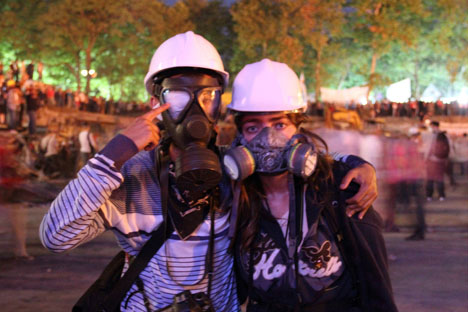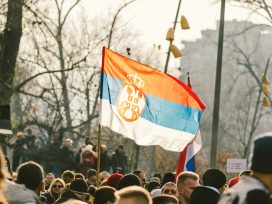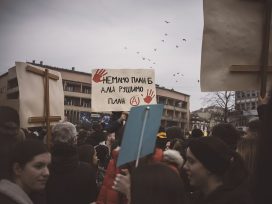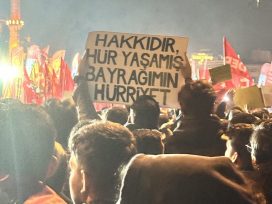Events are unfolding fast in Turkey. No one would have imagined that protests against building over a green space in Istanbul would lead to a countrywide explosion of social unrest. But within days, it was clear: nothing in Turkey would ever be the same again. Some have already branded the daily mass protests a “Turkish Spring”.
Many are just as astonished by the increasingly severe response to the demonstrations on the part of the Turkish government and the prime minister, Recep Tayyip Erdogan. At one stage, weeks of clashes on a level approaching civil war gave way to a rapprochement between protesters and police: Erdogan had assured the protesters that he would await the decision of the administrative court handling the case of the disputed construction plans for Gezi Park, and possibly even hold a referendum on the matter. Shortly after which, the prime minister had the occupied park brutally cleared once again; and, in a speech before hundreds of thousands of his supporters, described the demonstrators as “terrorists”.

Gezi Park. Photo: Burak Su. Source:Flickr
According to media reports, at least five people have been killed during the uprisings and around 5000 wounded; ten have lost an eye. Clearly, the battle that has been going on for years between Turkish political Islam and (both new and old) advocates of a secular democracy has entered a new phase.
It all began with the “harmless protest of a handful of environmentalists wishing to protect 15 trees”, as Erdogan put it. Gezi Park is attached to the centrally located Taksim Square. The immediate surroundings include five-star hotels and the Atatürk Cultural Center – as well as the square’s landmark Republic Monument. Also located nearby, between Gezi Park and the Bosporus, is the district of Harbiye, where traditionally the secular middle and upper classes live. Taksim Square is therefore the focus of liberal and, one might even say, libertarian Istanbul insofar as this exists: a place in which to hang out as well as to protest, where demonstrations take place on a daily basis; a kind of “Große Freiheit” with arts and cultural institutions. To the dismay of conservatives, the district of Pera had already emerged in the nineteenth century, with its foreign embassies and trading houses; Christian and Jewish minorities as well as Europeans populated the area. It is now known as Beyoglu and, together with Taksim at its centre, has been a flashpoint for many years, with its liberal atmosphere and protests against the government. In addition, Gezi Park is known for gay and transvestite prostitution.
As such, Erdogan’s plans for building on the square are powerfully symbolic. Ultimately, the effect would be to change the character of the part of Istanbul that is most oriented toward the West and most secular.
Politics and symbolism
Necmettin Erbakan (1926-2011), the founder of modern Turkish Islamism, had wanted to build a large mosque on Taksim. However, Erdogan’s plan is different: in September 2011, at his behest, the municipal authority took the decision to reconstruct an Ottoman barracks in Gezi Park. In January 2013 the local heritage authority rejected the decision on the basis that the park belongs to “Istanbul’s collective memory”. The municipal authority, which is controlled by the Justice and Development Party (AKP), succeeded in appealing the local heritage authority’s decision and was permitted to go ahead with the construction of the huge barracks. The building was not intended for military use but to house a shopping centre, luxury flats and related facilities. Unconfirmed rumours that Erdogan’s son-in-law had received the contract for the construction project later fuelled the protests further.
On 31 May 2013, an Istanbul administrative court ordered a temporary halt to construction work. But it was too late: on the night of 28 May, workers had already began to rip the trees out using bulldozers. The news spread instantly via Twitter and other social media. Around two dozen people, the leftist politician Sirri Süreyya Önder among them, literally threw themselves in front of the machinery. As it grew light, hundreds of protesters, most of them students, gathered in the park with a view to stopping the work through civil disobedience and the first small tents sprang up. The next morning, one could experience subsequent events virtually live via mobile phone shots: how plain-clothed policemen entered the park, piled up the tents, set fire to them and drove the young people away.
They did not, however, leave willingly. On the very same day, thousands gathered in the park. And although leftist splinter groups were also present, the protest mostly consisted of children from urban, secular milieus and environmentalists. They used smartphones and tablets, knitted small “pieces of clothing” with which to dress tree-branches, painted banners, made music and simply maintained a presence there. Gradually, more senior people joined them: university professors who had experienced years of limitations on their academic freedom; film people who had protested for weeks against the demolition of Beyoglu’s oldest cinema to make way for a further shopping centre; and musicians and theatre people who, following the establishment of a new state cultural body and drastic cuts in the funding of public institutions, had experienced something of a hiatus in cultural life. One felt that, on this particular day, a new spirit of resistance had developed in the park, a strong liberal opposition that had, until then, not existed under Erdogan.
Twitter vs teargas
And yet, the next day (30 May), the police returned to the park under the cover of darkness; this time armed with teargas, which they used aggressively. They tore down the tents and everything inside them and burned the whole lot. Though the panic was considerable, the park’s occupiers filmed and tweeted everything. The whole country could therefore witness the aggression of the police that day and on the days that followed too.
In the interim, millions took to the streets – not only in Istanbul but also in Ankara, Izmir, Edirne, Bursa, Antakya and other cities. The protests against the government and, in particular, those against the prime minister himself took on a local character. Citizens gathered in each neighbourhood, blocked the main street and banged pots and pans from their windows. Everywhere, the call of “Tayyip istifa” – “Erdogan resign” could be heard.
Three interdependent groups could be distinguished among the protesters: the young urban generation, the secular middle and upper classes as well as the, often somewhat older, leftist and left-liberals.
The latter had, for a lengthy period, supported Erdogan’s government in their battle against the Kemalist military elite. However, in recent years, they had grown increasingly dissatisfied. Urban freelancers, artists and intellectuals, who had originally come up against considerable obstacles in the way of working together with the middle class, whom they considered broadly speaking Kemalist, were literally pushed into becoming opposition as a result of the AKP’s uncompromising policies. Indeed, Erdogan never looked like compromising once and, in many of his speeches, interpreted the protests as a conspiracy directed from abroad against his government. In addition, the content on political Islam in his speeches had become all too pronounced, the address he gave to a reception of his own, angry young supporters at the airport upon returning from a trip to northern Africa being a case in point. Here Erdogan laid into the protest movement, saying, “They have attacked my veiled daughters and my veiled sisters […] They barge into the mosques carrying beer bottles and wearing shoes. They have no respect whatsoever for our faith.” At the end of the speech, the crowd chanted, “Give us the sign and we shall smash Taksim!” In fact, Erdogan calmed his supporters down and expressly told them to return home in a dignified manner. But the truth of what had happened in the mosques could scarcely have been more different: a large mosque on the Bosporus had received fleeing, wounded civilians and volunteer doctors had treated them there, following the police’s shockingly heavy handed use of tear gas. And although he denied Erdogan’s claims, the Imam faced an official inquiry into his conduct. It was then, at the latest, that the liberals stood at the crossroads.
The protest of a new generation
It was, however, primarily the generation born after 1990 that defined the protests. They made the digital platforms into the new vehicles of protest. Thus, the young urban, well-educated but reputedly apolitical generation of under-thirties actively articulated their understanding of freedom and direct democracy for the first time. They connected with a diffuse democratic, global anti-capitalist movement. Their central concern is distilled in the slogan, “What I believe, the language I speak, what I eat and drink, who I love and vote for is none of your business!”
Members of this new generation of protesters can get along just as well with Kurds and veiled girls as with the peaceful demonstrators of the Right. If a group of “Revolutionary Muslims”, or leftist Islamic activists, gather in the park for Friday prayers, a security ring forms around them and keeps things peaceful. Some wear Guy Fawkes masks, many are extraordinarily creative in inventing new slogans. Thus the protesters reappropriated the word “capulcu” (Turkish for “looter”), which Erdogan first used to describe the protesters, and it began to appear in other languages too. One of the protesters’ placards said “Introduction to Turkish Sociology 101: What is chapulling?” Other slogans such as “Neither revolution nor Sharia – only respect”, “Your tear gas only turns us on”, “I asked God, he said, resist!”, or “Don’t worry, we’re only the people!” provide an idea of the atmosphere on the streets. The opposition Kemalist Republican People’s Party (CHP) could only “tag along on the back of the protest movement”, as its leader Kemal Kilicdaroglu said. As such, there are significant parallels between the protests and Occupy Wall Street.
When protesting, the activists pursue thoroughly ethically principles. They watch out for each other, listen to one another, take their rubbish with them. After some days, the Gezi protesters even banned the bars serving alcohol in the park. They feared that those distributing beer for free there were plain-clothed police and would distract them from their aims. The government had already passed a law during a Parliament session one night at the end of May to forbid the sale of alcohol after 10 pm. Any alcohol advertising and related sponsoring of festivals was also banned. The beer breweries, such as Efes, and the Association of Turkish Winegrowers then purchased space in the newspapers, where they expressed their dissatisfaction at these developments. Erdogan responded angrily in a speech, saying that, having abided by “laws made by a couple of drunkards” up until now, they objected to a law that “our religion stipulates”. That Erdogan meant the founder of the Republic Mustafa Kemal Atatürk when he referred to those “drunkards” was clear to everyone.
As a result, a new tone crept into politics and entered more and more into the public sphere. Thus, at the end of May on a platform in the Ankara Metro: “Behave morally!” demanded an official voice, issuing forth from a Metro loudspeaker, of a couple kissing. Shortly afterwards, some young people used the Internet to organize a kissing flashmob in exactly the same spot. However, a small but voluble group of young Islamist men drove the protesters away and even attacked and wounded some with knives.
More and more people are becoming increasingly concerned over the Turkish support for the Islamic fighters in Syria. But since Erdogan keeps the mass media tightly under control, there are no longer any channels through which such concerns can be publicly discussed. Rumours of corruption no longer find their way into newspapers and many critical journalists have lost their jobs or even ended up in prison; many fear that they are being spied upon. At the same time, the level of trust in the justice system has sunken enormously.
A stumbling block: The division of powers
Erdogan has recently spoken of the division of powers as a “troublesome stumbling block” and openly made preparations for a presidential system – with a view to continuing to govern from 2015 onward in a new office invested with yet more power. This has only strengthened the growing discontent. Erdogan has obviously set his sights on remaining Turkey’s supreme head of state right up until the Republic’s centenary in 2023. Some observers try to gloss over these efforts with new concepts such as “authoritarian democracy”. However, the latest protests in particular have made it increasingly clear that democracy, transparency and fighting corruption belong together, as do a free press and freedom of expression and assembly, along with questions of gender and equal opportunities.
The various divisions in Turkish society according to different “ways of life” have been much discussed in recent years, but not deeply enough. The increasingly authoritarian power structures and relations at both economic and political levels are often overlooked, while attention is diverted toward a depoliticized cultural sphere. The thesis that Islamic countries have to search for and find a new way toward a non-western modernization process is also well worthwhile discussing, including with reference to economic development. By way of example, the conservatives have profited grandly from the redevelopment of metropolitan Istanbul.
In order to see off business people from the “secular sphere”, the rules of the market economy are bypassed too. Erdogan himself represents a new class of Anatolian business people who wish to assert their own interests against the dominance of the West. Had the colonialism of the West never in fact existed, Erdogan would have found it much harder to continuously portray Muslims as victims – and actually to conceive of them as such as well. His AKP party perceives itself as a key player in the mission “to rescue the Muslims”. From this perspective, the demands of the secularized, urban middle class are of absolutely no significance. At best, they are naive or even part of a larger conspiracy against the historical development of Islam.
The errors of the Left and the liberals
The AKP have denounced the attempts of secularist, Kemalist tutors to talk veiled students into opening up their headscarves at the door of the university as a sure sign of just how undemocratic the pretence of western democracy really is. On the other hand: how does one practice democracy? How does one teach democracy? This question, which Theodor W. Adorno already considered decisive for post-war Germany, is today more pressing for Turkey than ever.
For the leftist and liberal intellectuals in Turkey have made mistakes too. Between them, they have hardly been able to realize a democratic culture, instead allowing themselves to become polarized and, at times, instrumentalized. Following the referendum on the army’s position in society (which was voted upon only within certain limits) in 2010, they did not protest loudly enough as the government hollowed out measures for the division of powers in the resulting legislative package. They were not capable, on the one hand, of critiquing the authoritarian colossus Atatürk and, on the other, of defending themselves against the Kemalists and, at the same time, critiquing the secular, democratic system that the Kemalists had founded in opposition to the ancien régime.
The old leftist and left-liberal intellectuals have often ignored the cultural causes, rooted in authority and patriarchy, that contributed to the failure of Kemalist democracy. Above all, the growth of a completely new, liberal-oriented generation passed them by. They exploited the opportunity that the new mass media offered to boost their own profiles at the cost of the younger generation – to an extent that bordered on bigotry and losing touch with reality. Once Erdogan’s regime started to imprison inconvenient types on the basis of doubtful charges, they hesitated for a long time before at least demanding legal justice. They were correct in wanting to distinguish themselves from nationalists but, in so doing, overlooked the fact that the polarization of good and evil benefited political Islam and not democracy.
This has now prompted people to look at things anew in Turkey: it seems to many today all the more important to find a third way between the fronts. For there are those who sympathize with the liberal-democratic canon of values on both Islamic and Kemalist fronts. Dividing the world along religious lines obscures more than it explains. The Gezi Park protests have shown that there is a new way. And that means, regardless of how the demonstrations will end, this is a turning point in contemporary Turkish history – and a great ray of hope.







